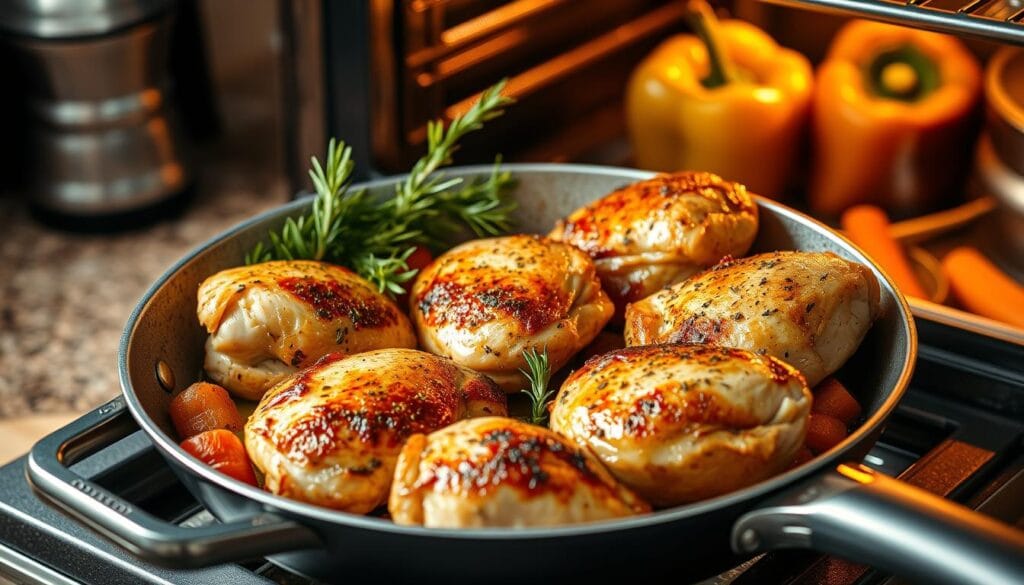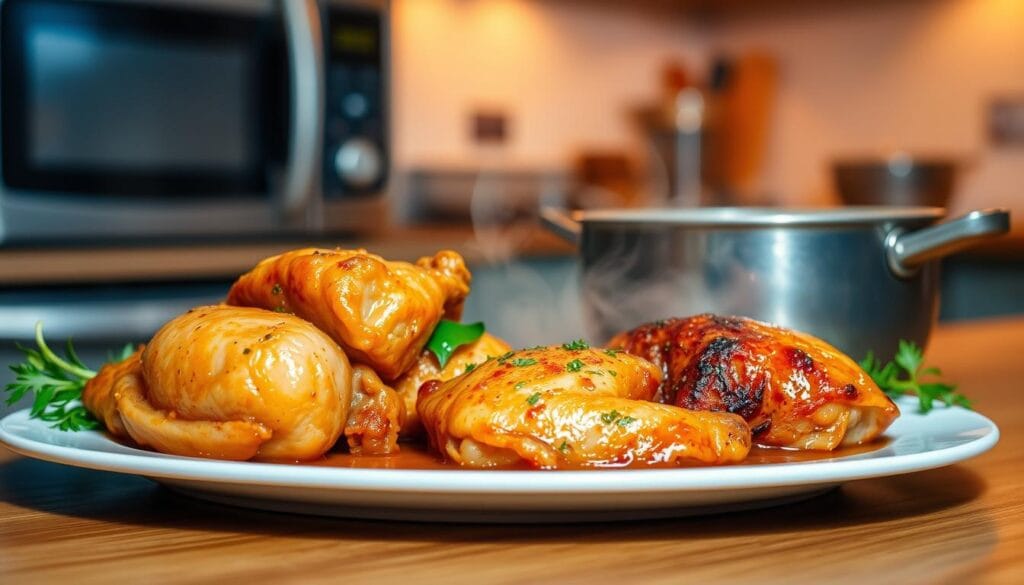What is the secret to juicy chicken? It’s a question many home cooks, including myself, have tried to answer. My mom’s grilled chicken was famous in our family—perfectly tender, full of flavor, and mouth-wateringly moist. I’ve experimented with countless methods, from brining to basting, but the real key lies in understanding the science behind cooking chicken.
In this article, we’ll uncover the secrets to making chicken juicy and delicious. By mastering temperature control, understanding meat fibers, and using the sear and bake method, you can create chicken dishes that everyone will love.
Understanding the Science Behind Juicy Chicken
To get perfect, juicy chicken, you need to know the cooking science. Temperature is key to bringing out the chicken’s full flavor and moisture. The USDA says to cook chicken to 165°F to kill harmful bacteria.
The Role of Temperature in Chicken Cooking
Chicken’s internal temperature keeps rising after it’s off the heat. This is called carryover cooking. It can raise the temperature by 5-10 degrees. Pulling the chicken at 160°F helps it reach 165°F without overcooking.
How Carryover Cooking Affects Moisture
Carryover cooking helps keep chicken moist. If you take it out too soon, it won’t be safe. But waiting until it’s 165°F can make it too dry. Finding the right balance is key for tender chicken.
How Meat Fiber Structure Unlocks the Secret to Juicy Chicken
The meat fibers affect how chicken holds moisture. Dark meat, like thighs, has more fat and connective tissue. This makes it stay juicy longer. But white meat, like breasts, needs careful cooking to stay moist.
“The key to juicy chicken is all about finding the sweet spot between doneness and carryover cooking. With the right temperature monitoring and an understanding of meat fiber structure, you can unlock the secrets to perfectly cooked poultry every time.”
What is the Secret to Juicy Chicken?
The secret to juicy, flavorful chicken is in a few key techniques. First, controlling the temperature is key. Use a meat thermometer to check the chicken’s internal temperature. This ensures it’s cooked right without drying out.
Another important step is the sear and bake method. First, sear the chicken in a hot skillet for a crispy crust. Then, bake it gently in the oven to keep it moist. This mix of high-heat searing and gentle baking makes the chicken juicy and flavorful.
Lastly, let the chicken rest for 10 minutes after cooking. This lets the juices spread evenly, making the meat tender and flavorful. By following these steps – controlling temperature, using the sear and bake method, and resting – you’ll get juicy and delicious chicken every time.
| Cooking Time | Salt Measurement | Internal Temperature |
|---|---|---|
| Total cooking time: 30 minutes Resting time: 10 minutes | ¾ to 1 teaspoon per pound | 165°F (74°C) for safe consumption |
“The secret to juicy chicken is all in the technique. Follow the sear and bake method, and your chicken will be moist and flavorful every time.”
Mastering these key elements will help you make perfect juicy chicken. Remember, focus on temperature, cooking method, and resting time. This will ensure your chicken is always moist and delicious.
Essential Equipment for Unlocking the Secret to Juicy Chicken
To get juicy, flavorful chicken at home, you need the right tools. From the pan to the thermometer, each piece is key. Let’s look at the must-haves for cooking chicken like a pro.
Choosing the Right Skillet
A heavy-bottomed skillet, like cast iron, changes the game for chicken. It cooks evenly and keeps heat well. This means your chicken gets a crispy outside and stays juicy inside.
Importance of Meat Thermometers
An instant-read meat thermometer is essential. It ensures your chicken is cooked just right. Don’t guess; use the thermometer to check the chicken’s internal temperature at 165°F.
Additional Kitchen Tools
There are more tools to help with chicken cooking. These include:
- Tongs for safely handling and turning the chicken
- A splatter screen to prevent oil and grease from making a mess
- Paper towels for patting the chicken dry before seasoning
- A sturdy cutting board for resting and slicing the cooked chicken
With the right chicken cooking equipment, like a quality meat thermometer and essential kitchen tools, you’ll cook perfect chicken every time.
The Sear and Bake Method: A Secret to Juicy Chicken
Achieving juicy, flavorful chicken is an art. The sear and bake method is a chef’s secret. It combines a caramelized crust from searing with a tender, moist interior from baking. This method can elevate your chicken dishes to new heights.
To start, season your chicken breasts with spices and herbs. Use paprika, garlic powder, and a pinch of salt and pepper. Heat a cast iron skillet over high heat and add oil. Once the oil is shimmering, place the seasoned chicken breasts in the pan and sear for 3-4 minutes per side, until golden-brown.
After searing, transfer the skillet to a preheated 375°F oven. Bake for 15-20 minutes, checking the internal temperature with a meat thermometer. Aim for an internal temperature of 165°F to ensure the chicken is cooked through without drying out.
| Recipe | Total Time |
|---|---|
| Baked Lemon Chicken | 50 minutes |
| Chicken Burrito Skillet | 45 minutes |
| Kentucky Grilled Chicken | 45 minutes |
| Mongolian Chicken | 35 minutes |
| Quick Chicken Piccata | 30 minutes |
| Peanut Butter Chicken Skewers | 30 minutes |
| Herbed Chicken Caesar Salad | 25 minutes |
The sear and bake method is a game-changer for sear and bake chicken and other chicken cooking techniques. It combines the best of both worlds. You’ll get a crispy, caramelized exterior and a juicy, tender interior every time. Try it and see the difference for yourself!
“The secret to juicy chicken is all in the technique. The sear and bake method is a must-try for anyone who loves perfectly cooked chicken.”

Temperature Guidelines for Different Chicken Cuts
It’s important to cook chicken to the right temperature. This ensures it’s juicy and safe to eat. The temperature needed varies by chicken cut.
White Meat Cooking Temperatures
For white meat like breasts and wings, cook to 155°F (68°C). Let it rest for a few minutes. This will raise the temperature to 165°F (74°C).
Dark Meat Cooking Temperatures
Dark meat, like thighs and legs, needs a higher temperature. Cook it to 170-175°F (77-79°C). This makes it tender and juicy.
Whole Chicken Temperature Guide
Roasting a whole chicken? Aim for 155°F (68°C) in the thigh. The breast will reach 160-165°F (71-74°C) while resting. This balances the meat’s doneness.
| Chicken Cut | Recommended Internal Temperature |
|---|---|
| Chicken Breasts | 165°F (74°C) |
| Chicken Wings | 165°F (74°C) |
| Chicken Thighs | 175-180°F (79-82°C) |
| Whole Chicken | 155°F (68°C) in the thickest part of the thigh |
Use a meat thermometer to check the chicken’s temperature. This ensures it’s safe and tasty. Always let the chicken rest before serving. This lets the juices spread evenly.
Proper Seasoning Techniques
Achieving juicy, flavorful chicken starts with the right seasoning. Proper seasoning is crucial for maximizing the taste and texture of your chicken dishes. Here are some tips to help you season your chicken like a pro:
- Use the right amount of salt. As a general guideline, aim for about ¾ to 1 teaspoon of salt per pound of chicken. This helps to enhance the natural flavors and retain moisture during cooking.
- Create a balanced seasoning blend. A classic poultry seasoning can include a mix of salt, black pepper, onion powder, garlic powder, paprika, dried oregano, thyme, basil, and a touch of cayenne pepper. This combination of spices and herbs will give your chicken a delicious depth of flavor.
- Explore pre-made seasoning mixes. If you’re short on time, opt for pre-made seasoning blends like Italian, Cajun, or Blackening seasoning. These ready-to-use mixes can simplify the seasoning process while still delivering great flavor.
For an extra flavor boost, consider marinating your chicken in a mixture of chicken marinade ingredients like citrus juice, herbs, and oil. Alternatively, brush the cooked chicken with melted butter or drizzle it with a squeeze of fresh lemon juice to add a final touch of moisture and flavor.
“The key to juicy, flavorful chicken is all in the seasoning. Don’t be afraid to experiment with different spice blends and marinades to find your perfect flavor profile.”
Remember, the quality of your chicken seasoning can make all the difference in the final dish. Take the time to properly season your chicken, and you’ll be rewarded with incredibly moist and delicious results every time.
Common Mistakes to Avoid
Cooking chicken can be tricky, even for experts. To get juicy, tasty chicken, it’s important to avoid common mistakes. Let’s look at some big issues to steer clear of.
Overcooking Issues
Overcooking is a big problem that makes chicken dry and tough. It can happen quickly, turning perfect chicken into a stringy mess. To avoid this, always check the chicken’s internal temperature with a meat thermometer.
The ideal temperature for chicken breasts is 165°F. But, they might reach about 170°F by the time you serve them. This is because of carryover cooking.
Seasoning Errors
Seasoning is key for tasty chicken, but mistakes can happen. Failing to use enough seasoning or spreading spices unevenly can result in bland flavors. To avoid this, ensure your chicken is well-coated with a mix of salt, herbs, and spices for maximum flavor.
Also, make sure the seasoning is spread out evenly. This will help your chicken taste great all the way through.
Resting Time Mistakes
Not letting the chicken rest is another common chicken cooking mistake. It’s important to let the chicken rest for at least 10 minutes before cutting into it. This lets the juices spread out evenly in the meat.
Cutting into the chicken right after cooking can make it dry and disappointing. So, always let it rest before serving.
By avoiding these common mistakes and following best practices, you can make your chicken cooking better. This way, you’ll always get juicy, flavorful results.
Storage and Reheating Tips
Keeping chicken juicy and flavorful is all about how you store and reheat it. For chicken storage, use an airtight container in the fridge for 3-4 days or freeze it for 2-3 months. This keeps the chicken moist and prevents it from drying out.
Reheating chicken right is key to avoid making it dry and tough. The best way is to use a skillet with a bit of water or broth. Let the chicken sit at room temperature for 10-15 minutes before slicing it into 1-inch pieces. Then, heat the skillet with oil, add the chicken, cover, and cook for 1-2 minutes on each side. This method keeps the chicken juicy and tender.
You can also reheat chicken in the oven at 375°F for 20-25 minutes, covered with foil. Or, use the microwave with a small amount of broth in 1-minute intervals until it’s warm. Just don’t overcook it, as that can make it tough.
| Reheating Method | Time and Temperature |
|---|---|
| Skillet | 1-2 minutes per side on medium heat, with a splash of water or broth |
| Oven | 20-25 minutes at 375°F, covered with foil |
| Microwave | 1-minute intervals, with a small amount of broth |
By using these reheating chicken tips, you can enjoy your leftover chicken without losing its juiciness and taste. Remember, the right storage and reheating are crucial to keep your chicken delicious.

Conclusion
Getting juicy, perfectly cooked chicken is easy with the right techniques. Knowing the science of cooking temperatures and using the right tools helps. Mastering the sear and bake method and avoiding common mistakes are key. Always use a meat thermometer, let the chicken rest, and season well for the best juicy chicken tips.
With these tips, you’ll cook like a pro at home. Brining, marinating, and basting keep chicken moist. Techniques like butterflying breasts and braising dark meat can make your chicken even better. Follow this article’s advice to make juicy, flavorful chicken every time.
Try these juicy chicken tips tonight. Experiment with different cuts, cooking methods, and seasonings. With practice and the right approach, you’ll make chicken dishes that wow everyone.

